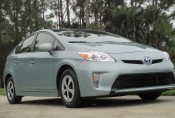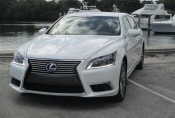2013 Toyota Avalon Hybrid
Toyota’s flagship car has been completely redesigned for a more youthful appeal and for the first time can now be ordered as a hybrid.
Taking a car that’s long been considered the preferred ride of the senior set and broadening its audience isn’t an easy proposition. The Avalon is the next purchase for the Camry owner looking to graduate to Toyota’s premium car. And what’s happened here is mostly very positive, particularly on the design side where this U.S. penned body is a unanimous winner. I’ve already driven an XLE Premium with the super strong V6 and now I’m in the Hybrid of the same trim level, a car priced from $36,350. There is one trim below this car and 2 above it spanning a total dollar range of over $8,500.
The hybridization of the Avalon follows typical Toyota form by utilizing a 2.5-liter 4-cylinder gas engine running the Atkinson cycle – that’s where the intake valve closing is retarded for improved efficiency – and pairing it with a transaxle which houses 2 electric motor generators; 1 acting as a starter and charging the hybrid battery and the 2nd boosting the effectiveness of the gas engine and providing electric power for propulsion on its own. The latter can only happen at speeds up to 20mph for about 1 mile. Sticking with the old school Nickel metal-hydride battery, Toyota buries it as close to the rear seat as possible to preserve trunk space.
Most hybrids loose considerable cargo room due to the space requirements of the battery, but the Avalon retains all but 2 cubic feet still leaving an ample trunk.
The hybrid power control unit is located up here and converts the high voltage to useable levels while also coordinating all of the system’s functions. Regenerative braking and the use of a CVT transmission round out the hybrid traits, helping this Avalon Hybrid achieve an EPA rating of 40mpg city/39mpg highway while my weekly average with lots of un-hybrid like driving for the purpose of testing was about 37mpg. Total system output is 200 horsepower which spawns a 0-to-60mph time of about 8-seconds.
The hybrid offers 3 selectable driving modes: one for short distance, low-speed electric operation, an ECO setting for improved efficiency and my favorite – a transformative Sport mode which brings this Avalon to life.
Toyota’s experience with hybrids shines through as this car drives with a fluidness that’ll have you forgetting it even is a hybrid. If it weren’t for the electric whirring noises and the gauges which show energy flow, you might not even realize. From the outside, the Hybrid is marked by blue-trimmed emblems, hybrid badges and its hidden exhaust outlet.
The same discussion points I posed in my initial Avalon test I revisit here. It doesn’t clearly distinguish itself from the Camry anymore from a size standpoint and in redefining the car’s handling abilities, the ride has become much too firm for this class of car. And a flagship car should not at any trim level have such a clunky looking do nothing screen as this. That said, this is one instance where I prefer the Hybrid over the gas model. The price premium is about $2,300 – $950 of which you’ll likely get back in gas savings during year one. Plus its drives so transparent to its hybrid powertrain that I never lamented its presence. MSRP of my tester with a couple of nominal options is $37,169. Toyota’s bigger car goes green in a very good way.

 2021 BENTLEY BENTAYGA V8 TEST DRIVE
2021 BENTLEY BENTAYGA V8 TEST DRIVE 2013 Toyota Prius – Quick Takes
2013 Toyota Prius – Quick Takes 2013 Lexus LS 460 L – Quick Takes
2013 Lexus LS 460 L – Quick Takes